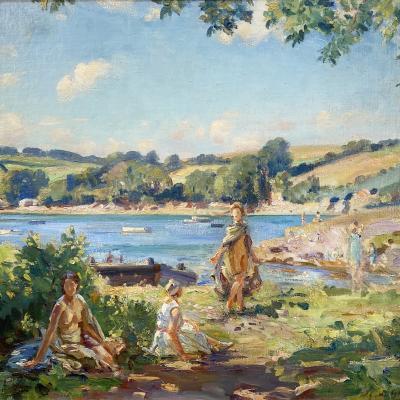artist
De Glehn is perhaps most famous for his association with John Singer Sargent. Born in Sydenham, England in 1870, he received his training in the Royal College of Art in South Kensington and later at the Ecole des Beaux-Arts in Paris where he studied under Gustave Moreau and Elie Delaunay. De Glehn met Sargent in 1895 through Edwin Austin Abby during his first visit to America when Sargent was working on murals in the Boston Public Library. After further work in Europe, de Glehn returned to the US in 1903 and married Jane Emmet, a member of a Boston family of painters and cousin to the novelist Henry James. Shortly afterwards the newly wed couple returned to Europe with Sargent where they embarked on many years of travel throughout Spain, Switzerland and Italy. Sargent would become renowned in the years to come. There was always a circle of other painters and artists around them, with de Glehn and Sargent always at the center, usually painting side by side from location to location, often using Mrs. De Glehn or Sargent’s sisters as models. These years were very productive and successful for de Glehn who built an impressive body of work, and always in the company of painters of the caliber of Sargent whose influence and experience were ever-present.
Wilfred de Glehn was thoroughly cosmopolitan in his upbringing and outlook. He was born Wilfred Gabriel von Glehn in Sydenham, South London, and was educated at Brighton College. His father, Alexander von Glehn, was involved in the building of narrow-gauge railways in France, as well as being a coffee-merchant. Alexander was the son of Robert von Glen, a Baltic baron with estates near Tallinn in Estonia. He became a naturalized British subject following his marriage to Louise Creighton, a Scottish woman who was an author and a women’s rights activist. Wilfred attended Brighton College and left in 1889, spending a very brief period at the Royal Academy Schools, South Kensington. Later he enrolled at the Ecole Nationale des Beaux-Arts in Paris and by 1891, he lived with his French cousin, the artist Lucien Monod. In 1891, he was hired by Edwin Austin and John Singer Sargent to assist them on their Boston Public Library mural project at Morgan Hall.
By 1900, de Glehn had already begun to come into his own as a painter. He joined the NEAC or the New English Art club, an alternative venue to the Royal Academy, befriending both Henry Tonks and Philip Wilson Steer, and exhibited at the Paris Salon, the Royal Academy, the New Gallery and the Royal Society of Portrait Painters. His first solo exhibition was held at the Carfax Gallery in 1908.
De Glehn met American-born artist Jane Erin Emmet in New Rochelle, New York in 1903, and they were married there the following year. De Glehn held an important role in Anglo-American art circles, fraternizing with a group of prominent cultural figures that included painters Frank D. Millet and J. Alden Weir, architects Stanford White and Charles McKim, the collector Isabella Stewart Gardner, and the novelist Edith Wharton.
Following their wedding, the couple honeymooned in Cornwall, England, vacationed in Paris and Venice, and made a permanent home in Chelsea, London. However, they travelled extensively, often accompanying Sargent on his trips through Europe. When World War I intervened, husband and wife joined the staff of a British hospital for French soldiers, Hôpital Temporariaire d’Arc-en-Barrois, Haute-Marne, France in January 1915, working for the Franco-British Red Cross.The following year, de Glehn was commissioned and served with the Royal Garrison Artillery. He was seconded to the front in Italy in 1917. In May 1917, his family shed the Germanic 'von Glehn' surname. Because of his fluent French, he spent the last part of the war as an interpreter. After the war, de Glehn held solo exhibitions at the Leicester Galleries and in New York (1920).
In April of 1941 the de Glehns' home and studios of nearly forty years at Cheyne Walk were completely destroyed by a parachute bomb, which hit the neighboring Old Church in Chelsea. Having spent many of the months since the war had been declared with Wilfred's brother in Grantchester, near Cambridge, any plans to return home to London were now impossible. With so many of their old friends gone from the area too, including Sargent, there seemed little point in renting elsewhere in Chelsea. In March of 1942 the de Glehns moved permanently to their new home in Stratford Tony, not far from the house they had been renting at Wilton in Wiltshire.
provenance
Gene Shannon, Connecticut
Private Collection Donald Purdy, Newtown, CT.




















